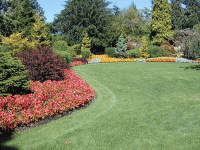Blog Categories
- Blog home
- Cariboo Chilcotin Coast (9)
- Mighty Fraser Country (19)
- Northern BC (10)
- The Kootenays (17)
- Thompson-Okanagan (19)
- Tourism Associations (3)
- Uncategorized (0)
- Vancouver (197)
- Vancouver Coast Mountains (26)
- Vancouver Island (110)
- Victoria (57)
- Whistler (17)
Related Travel Information
Queen Elizabeth Park
Of Vancouver’s three horticultural gems, Queen Elizabeth Park west of downtown takes a different approach from the other two. VanDusen Botanical Garden is just that and so is the University of British Columbia’s. Queen Elizabeth Park is dedicated more to an overall aesthetic than to the grouping and identification of specific plant families. Furthermore, besides the gardens it has lawn space for games including golf, but just the miniature variety.
Queen Elizabeth is a masterpiece of reclamation and transformation. What was once a big hole in the ground, a former basalt quarry, is now from the top of the hill it was carved from a vista of color in its overflow of bedded plants and a complex of winding tree and shrub lined paths that descend to the bottom. These thread through massed flowers in beds with shades of rose, orange, pink, white and purple and along or over a small stream that runs through the place where the quarrying stopped. Not surprisingly, they are formally called the Quarry Gardens.
The park claims to be one of the most beautiful public gardens anywhere in the world. From those I’ve seen — the Boston public garden, New York’s Central Park or the mall in Washington D.C. — I agree. It is also handy at Cambie Street and West 33rd avenue, and not just by car. Not only is there a bus stop close by on Cambie, with fast, comfortable bus service that impressed me, a non-bus lover. But there also is a stop on the new Vancouver subway line that just opened, from downtown to the airport.
Credit for the transformation of a swath of property sold to Vancouver by the Canadian Pacific Railroad in 1928 goes to William Livingstone. As a 1991 plaque at the start of one of the paths from the hilltop to the bottom plantings testifies, he was deputy superintendent at the Park Board and chief horticulturist when the work started.
Twenty years after the land purchase, Livingstone put his horticultural staff to work on turning a pit into a vista. From the top of the site, the highest at 500 feet in Vancouver, there is a macro vista of downtown Vancouver and the Coast Range. At the bottom of the bowl is a micro vista of oversize flower beds, often plants of the same species and color that circle around a central lawn. Through the base wanders a small, clear stream with bridges and fords.
Besides the 3,000 trees on the entire site, plus the bedding plants, there are shrubs, including what I identified as mountain laurel at the base of one of the paths down, and a truly magnificent specimen. I always try to catch it covered in pink bloom in June or July.
The only problem for the inquiring visitor is the lack of labels, which is not the case at VanDusen and the university botanical gardens. Take my “mountain laurel,” It’s pink flowers and bloom time didn’t necessarily match up with the description I gleaned from a web search. Obviously a familiarity with plants and trees is a big help, but missing that so is a plant guide or handbook. Absent labels, that would be a huge task to place now, a plants-in-the-park guide sold by the park would be a much help.
Similarly the bedding plants. Once upon a time I could have identified many of these from experience. But time passes and memories fade. That confounds a plant enthusiast, but few if any of the other visitors we saw there seemed to have a problem. They just enjoyed the beauty and the setting.
Our grandchildren were oblivious to all this. They enjoyed running around the paths and especially seeing how close they could come to the streams without falling in — though none is deep enough to cause grief. They also had lots of fun trying to crane over the chain-link fence
My family has been there as summer visitors. But it doesn’t take much imagination to visualize the park in autumn as the leaves change on the deciduous trees and shrubs. Many of the trees are conifers, though, so they stay green all year and don’t contribute to autumn color. In winter, though, they keep the park from turning leafless. Spring, too, must be impressive as the plants revive and the early blooming specimens start to flower.
There is also a greenhouse garden for tropical plants, the Bloedel Floral Conservatory. While access to most of the park is free, admittance is charged for this indoor garden. Both VanDusen and UBC charge entrance fees, so that is something to consider for a visitor.
Which of the three should a time-constrained visitor choose? I try not to miss any one of the three when I come. Otherwise it’s a matter of personal taste. Queen Elizabeth scores with the long-shot and close-up views and its ease of access, though VanDusen is close by. A point to consider for the university garden is the proximity of several parks and beaches near Spanish Bank that have soul-satisfying scapes of English Bay, Burnaby Inlet and the mountains toward Whistler. Take your choice.




